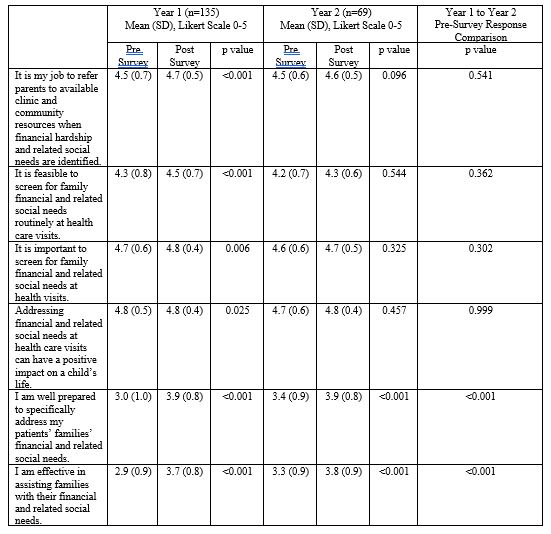Health Equity/Social Determinants of Health
Health Equity/Social Determinants of Health 5
440 - “TEACH”ing: Quantitative Evaluation of Year 1 & 2 of a Multimodal Child Poverty Curriculum
Publication Number: 440.219

Jessica Weisz, MD (she/her/hers)
Assistant Professor
Children's National Health System
Washington, District of Columbia, United States
Presenting Author(s)
Background:
Understanding and addressing child poverty is critical for equitable care. Few curricula discussing poverty exist and even fewer include multimodal teaching coupled with robust evaluation.
Objective:
To evaluate the effect of Years 1 and 2 of a child poverty curriculum on resident knowledge and attitudes.
Design/Methods:
The objective of the Trainee Education in Advocacy and Community Health (TEACH) curriculum is to train pediatric residents to recognize and address the effects of child poverty, with learning objectives modified from the US Child Poverty Curriculum (Chamberlain, 2016). Epidemiology of Poverty (Year 1) and Population Health & Social Determinants of Health (Year 2) include interactive modules with case simulations, multiple choice pre/post case-based knowledge questions, reflection questions, and experiential learning – completing a government benefits application (Year 1) and a home visit (Year 2). Each year, residents also complete pre/post questions assessing attitudes on a 5-point Likert scale regarding screening for poverty and social determinants of health. Attitude questions are based on a prior American Academy of Pediatrics Periodic Survey of Fellows. The statistical analysis of knowledge and attitudes paired resident pre- and post-responses. Residents who participated in Year 2 had already completed Year 1 of the curriculum.
Chamberlain LJ, Hanson ER, Klass P, et al. Childhood poverty and its effect on health and well-being: enhancing training for learners across the medical education continuum. Acad Pediatr. 2016;16: S155–S162. 3 suppl.
Results:
Residents demonstrated improved knowledge comparing pre- and post-test responses in each set of modules (Table 1). Post-participation in Year 1 and in Year 2, residents self-reported they felt more prepared to address social needs (p< 0.001) and more effective in assisting families (p< 0.001) (Table 2). Further, there was statistical improvement from pre-test responses Year 1 to pre-test responses Year 2 for residents feeling more prepared to address social needs (p< 0.001) and more effective (p< 0.001). All attitudes showed statistical interval change (p< 0.05) in Year 1 but not Year 2.
Conclusion(s):
This new analysis is evidence that resident knowledge and attitudes on poverty improve within each year of the TEACH curriculum and are sustained from Year 1 to Year 2. Next steps include assessment of Year 3 and assessment of resident application of learning objectives during a clinic visit.
.jpg)
